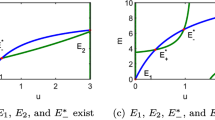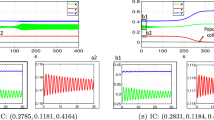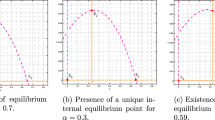Abstract
In most natural populations, intraspecies competition for natural resources is supplemented by a predator impact. The mode and intensity of the interaction between a prey and its predator may affect the course of competitive or sympatric speciation among the prey and processes of coevolution or cospeciation. Mathematical methods allow the development of models precisely describing all sides of intra- and interspecies interactions. In this paper, we use mathematical modeling to investigate the effect of the intensity of interspecies interactions on competitive or sympatric speciation inside a prey population. The intensity of the interaction is the average number of prey which predators eat pera unit of time: the higher the average number of prey eaten by predators, the greater the intensity of the interaction. In mathematical models, the intensity of such interaction is determined by many parameters. Changes in these parameters will affect the intensity of the interaction. It was found that a sufficiently high intensity of interaction slows competitive speciation among the prey. By altering their adaptive traits, the preys in this case seek to avoid the impact of predators. Another important result was that speciation of predators follows prey speciation when the probability of mutational changes in the adaptive traits of predators exceeds that in the prey.
Similar content being viewed by others
References
Abrams, P.A., The evolution of predator-prey interactions: theory and evidence, Annu. Rev. Ecol. Syst., 2000, vol. 31, pp. 79–105.
Barker, S.C., Whiting, M., Johnson, K.P., and Murrell, A., Phylogeny of the lice (Insecta, Phthiraptera) inferred from small subunit rRNA, Zool. Scripta, 2003, vol. 32, no. 5, pp. 407–414.
Bukin, Ju.S., Pudovkina, T.A., Sherbakov, D.Ju., and Sitnikova, T.Ya., Genetic flows in a structured one-dimensional population: simulation and real data on Baikalian polychaetes M. godlewskii, In silico Biol., 2007, vol. 7, no. 3, pp. 277–284.
Dieckmann, U. and Law, R., The dynamical theory of coevolution: a derivation from stochastic ecological processes, Math. Biol., 1996, vol. 34, pp. 579–612.
Dieckmann, U. and Doebeli, M., On the origin of species by sympatric speciation, Nature, 1999, vol. 400, pp. 354–357.
Dieckmann, U., Doebeli, M., Johan, A., Metz, J., and Tautz, D., Adaptive Speciation, Cambridge: Univ. Press, 2004.
Doebeli, M. and Dieckmann, U., Evolutionary branching and sympatric speciation caused by different types of ecological interactions, Am. Natur., 2000, vol. 156, pp. 77–101.
Emerson, B.C. and Kolm, N., Species diversity can drive speciation, Nature, 2005, vol. 434, pp. 1015–1017.
Forbes, A.A., Powell, T.H.Q., Stelinski, L.L., Smith, J.J., and Feder, L.J., Sequential sympatric speciation across trophic levels, Science, 2009, vol. 323, no. 5915, pp. 776–779.
Ginzburg, E.Kh., Opisanie nasledovaniya kolichestvennykh priznakov (Description of Inheritance of Quantitative Traits), Novosibirsk: Nauka, 1984.
Kolmogorov, A.N., A qualitative study of mathematical models of populations, in Problemy kibernetiki (Problems of Cybernetics), Moscow: Nauka, 1972, vol. 25, pp. 100–106.
Macdonald, K.S., Yampolsky, L., and Emmett Duffy, J., Molecular and morphological evolution of the amphipod radiation of Lake Baikal, Mol. Phylogenet. Evol., 2005, vol. 35, pp. 323–343.
Meixner, M.J., Carsten, Luter C., Eckert, C., et al., Phylogenetic analysis of freshwater sponges provide evidence for endemism and radiation in ancient lakes, Mol. Phylogenet. Evol., 2007, vol. 45, pp. 875–886.
Sasaki, A., Host-parasite coevolution in a multilocus gene-for-gene system, Proc. Roy. Soc. Biol. Sci. Ser., 2000, vol. 267, pp. 2183–2188.
Semovski, S.V., Bukin, Y.S., and Sherbakov, D.Y., Speciation and neutral molecular evolution in one-dimensional closed population, Int. J. Modern Phys., 2003, vol. 14, pp. 973–983.
Semovskii, S.V., Bukin, Yu.S., and Shcherbakov, D.Yu., Models of sympatric speciation in a changing environment, Sib. Ekol. Zh., 2004, vol. 5, pp. 621–627.
Sherbakov, D.Y., Kamaltynov, R.M., Ogarkov, O.B., and Verheyen, E., Patterns of evolutionary change in Baikalian gammarids inferred from DNA sequences (Crustacea, Amphipoda), Mol. Phylogenet. Evol., 1998, vol. 10, pp. 160–167.
Simms, E.L., The evolutionary genetics of plant-pathogen systems, BioScience, 1996, vol. 46, pp. 136–143.
Smith, V.S., Page, R.D.M., and Johnson, K.P., Data incongruence and the problem of avian louse phylogeny, Zool. Scripta, 2004, vol. 33, no. 3, pp. 239–259.
Svirezhev, Yu.M. and Logofet, D.O., Ustoichivost’ biologicheskikh soobshchestv (Stability of Biological Communities), Moscow: Nauka, 1978.
Takasu, F., Kawasaki, K., Nakamura, H., et al., Modeling the population dynamics of a cuckoo-host association and the evolution of host defenses, Am. Natur., 1993, vol. 142, pp. 819–839.
Takasu, F., Modelling the arms race in avian brood parasitism, Evol. Ecol., 1998, vol. 12, pp. 969–987.
Takasu, F., Co-evolutionary dynamics of egg appearance in avian brood parasitism, Evol. Ecol. Res., 2003, vol. 5, pp. 345–362.
Zaguskin, V.L., Spravochnik po chislennym metodam resheniya uravnenii (Handbook of Numerical Methods for Solving Equations), Moscow: FIZMATGIZ, 1960.
Author information
Authors and Affiliations
Corresponding author
Additional information
Original Russian Text © Yu.S. Bukin, 2014, published in Vavilovskii Zhurnal Genetiki i Selektsii, 2014, Vol. 18, No. 2, pp. 320–328.
Rights and permissions
About this article
Cite this article
Bukin, Y.S. Coevolution in a predator-prey system: An ecogenetic model. Russ J Genet Appl Res 4, 543–548 (2014). https://doi.org/10.1134/S2079059714060045
Received:
Accepted:
Published:
Issue Date:
DOI: https://doi.org/10.1134/S2079059714060045




